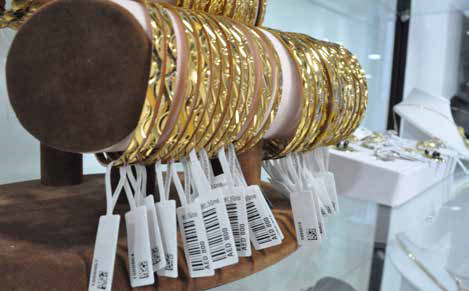The onset of buying season (mostly festive and wedding season) is the most crucial season for the gems and jewellery industry. During this time, the industry is in a hurry to either place orders for stocking or for restocking. However, a lot of plannin

In gems and jewellery industry, Inventory or Stock (as it is most popularly known as) is the main asset. But this asset at times becomes the liability due to lack of management or sometimes no management at the store level. Most of the times, either the inventory is in excess or is old and thus gathering dust. A number of retailers fail to move this inventory over a period of time, which becomes a liability. Many of them are positive of such inventory getting sold or expect that the consumer may demand it in future and if it’s not in the stock then they may lose on the business. Such behaviour adds only to your existing burden of on-the-shelf-non-selling-products.
Therefore, inventory control is a must. It is used to show how much stock you have at any one time, and how you keep track of it. It is all about every item you use to produce a product or service, from raw materials to finished goods. Efficient stock control allows you to have the right amount of stock in the right place at the right time. It ensures that capital is not tied up unnecessarily, and protects production if problems arise with the supply chain.
Firstly, let us know more about the stocks:
All that you use to make your products provide your services and to run your business is part of your stock. There are four main types of stock:
Stock value
You can categorise stock further, according to its value. For example, you could put items into low, medium and high value categories. If your stock levels are limited by capital, this will help you to plan expenditure on new and replacement stock. You may choose to concentrate resources on the areas of greatest value. However, low-cost items can be crucial to your production process and should not be overlooked.
Talking about role of inventory, Sachin Jain, MD, Forevermark India says “Inventory is a very important part of retail business, not just in jewellery industry but in every other business too. According to me, more than planning, one should have their nose on the floor i.e. one should understand their consumers need, demands and likings. 'What is their buying pattern and what they enquire for?' Do not repeat same old mistakes. Along with this, it is equally important to set a trend. Start your own trend which will be something new for your customers.”

Before You Buy…
Decide on how much stock to keep and this depends on the size and nature of your business as well as type of stock. One can also keep the stock with manufacturer or supplier to avoid storage cost. As a jeweller, your inventory is expensive and therefore it’s crucial for you that you decide on which items should be in your stock, as well as the number of pieces you should hold. To do this, one needs to have a replenishment system in place. Replenishment is the movement of inventory from upstream -- or reserve -- product storage locations to downstream -- or primary – storage, picking and shipment locations. The purpose of replenishment is to keep inventory flowing through the supply chain by maintaining efficient order and line item fill rates.
Besides there is need to have the interesting inventory which can set the trend. Commenting further on this, Biren Vaidya, MD & Creative Soul, The House of Rose said “Some of the important things I consider while buying my gemstones is to look at the quality, rarity, uniformity in the lots, salability and most importantly, the price. In terms of restocking, the right way to do so is to analyse the trends that have been in your particular retail store, category wise inventory that was sold, be it diamond necklaces, earrings, bracelets, etc.; analysing how much of it was in gold, the styles that sold the most, the collections that did really well and innovate and create a whole new line based on the information available to you. One has to know what kind of gems were selling at your store, the designs, and price points and then correcting them for the future in a manner you follow these styles. Always keep in mind that fast movers and generic products in demand must always be in stock.”
Adding to this Sachin Jain, MD, Forevermark India said “Your major percentage of stock can be what your consumers buy but some percentage should also be something from your side, something new, some fresh trend. It adds to the interest of the consumer to see something new. It is a challenge but it is worth trying.”
To buy better…
In depth study of the existing stocks and the demands of the particular region is crucial before you buy for the upcoming season. While one may be tempted to update the inventory as per the ongoing trends but one has to be careful of the consumer demands in a particular market. Also, one should be aware of the forthcoming trends and keep themselves updated.
Elaborating further on the need for market study before buying, Siddhartha Sawansukha, CEO, Sawansukha Jewellery Pvt Ltd said “Honestly, 200 years of experience doesn’t matter at all we don’t metamorphose with time. That happens only when we know the market well. Talking to clients and doing your homework regularly, not just helps to know what we have but also shows what we need to work on to improvise and be ahead of our competitors . Competition is really steep and the real challenge is delivering the best with a new trend and yet not losing out on our roots.”
Even Ketan Chokshi, Owner, Narayan Jewellers supported the need for market analysis as he said “You should have a proper analysis of your store’s inventory and details of the market before making any purchases. You also have to keep in mind and predict the upcoming trends so your stock sells faster.”

Stock Control Methods
As mentioned on www.infoentrepreneurs.org, there are several methods for controlling stock, all designed to provide an efficient system for deciding what, when and how much to order? You may opt for one method or a mixture of two or more if you have various types of stock. For further information, see the page in this guide on types of stock.
Minimum Stock Level - You identify a minimum stock level, and re-order when stock reaches that level. This is known as the Re-order Level.
Stock Review - You have regular reviews of stock. At every review you place an order to return stocks to a predetermined level.
Just In Time (JIT) - This aims to reduce costs by cutting stock to a minimum. Items are delivered when they are needed and used immediately. There is a risk of running out of stock, so you need to be confident that your suppliers can deliver on demand.
These methods can be used alongside other processes to refine the stock control system. For example:
Re-order lead time – Allows for the time between placing an order and receiving it.
Economic Order Quantity (EOQ) – A standard formula used to arrive at a balance between holding too much or too little stock. It's quite a complex calculation, so you may find it easier to use stock control software.
Batch control - Managing the production of goods in batches. You need to make sure that you have the right number of components to cover your needs until the next batch.
If your needs are predictable, you may order a fixed quantity of stock every time you place an order, or order at a fixed interval - say every week or month. In effect, you're placing a standing order, so you need to keep the quantities and prices under review.
Serialised Inventory Control
In case of luxury jewellery industry, Serialised Inventory is very important as luxury jewellers sell expensive items and they need an efficient way to track their inventory. A serial number can be associated to a finished product (a ring) and to a component of a product (a loose diamond). The serial number is used as a unique identifier to track the product’s movement throughout the retail environment, from receiving, to store transfers, to bin placement and final sale. As a jeweller your inventory is your most valuable asset, and there’s nothing more important than knowing where your jeweller pieces are at all times.
For Selling Better…
Most importantly, old age methods of selling need to be changed. Instead of thinking hard selling to be the only way, jewellers need to be more engaging as for customers buying needs to be an experience. The core focus needs to be on assisting the customer through every step from selecting the designs, to the final purchase.
Jewellery selling is no plainer selling but consumers are looking at an experience. Commenting on this, Sandeep Kulhalli, Senior VP, Retail & Marketing, Tanishq said “Jewellery is a very involved category with high value that is mostly bought by women. Engaging customers is extremely important if you want to beat the competition. Jewellers need to evolve as it is no longer a buy-sell experience. At Tanishq, we have gotten rid of the old and ancient baggage with our evolved strategies. Jewellers need to get over the old style of smooth talking, inventory show, and use of personal relationships, etc. Tanishq has always given customers space.”
Elaborating further on selling experience, Biren Vaidya, MD & Creative Soul, The House of Rose added “You must be confident and buy into it yourself first – the concept, design, and most importantly the story. The consumer of today isn’t merely interested in buying a product. She is interested in buying into the experience and the story behind the collection, the inspiration and the design and is looking for good quality. If you can express all these things to the customer, you have your sale.”
Besides, there is need to the industry to bringing in new talent, new professionals who are abreast with the technology. Talking about need to employ professionals, Sachin Jain, MD, Forevermark India said “Our industry needs to embrace change in terms of employing professionals especially when it comes to inventory as there are many technical things which only they understand, this helps business a lot. They know their job the best, can take right decisions and it helps in maintaining the stocks to a great level.

Apart from this, one needs expert sales team to add to the buyer-seller experience. “We believe the clients are always looking for quality and trust in the piece they buy. Our Sales team is equipped with knowledge of selling the product. Initially, the sales person should envisage the concept and techniques used behind every piece and are confident in selling that product to the customer. In addition, one has to consider customer preference as well,” said Siddhartha Sawansukha, CEO, Sawansukha Jewellery Pvt Ltd
Besides, jewellers can opt for various schemes, loyalty programs to help cement relations with the customers. Adding further on need for offers, Ketan Chokshi, Owner, Narayan Jewellers said ‘Always keep in mind the past trends, future projections and analyze consumer buying trends. You can make attractive offers which are hard to refuse or advertise about new collection to make people aware about the new launches.”
But what if your supply exceeds demand…
Most jewellers design some jewellery or collections that don’t sell at the end of the year. The goal is to manage inventory and distribution outlets tightly to minimise this. Besides, there is an option of remodeling or offering discounts on the existing stock.
In case, your stock sells quickly, you should analyze weather to restock it or move on to another stock. There may be a time when you restock the same jewellery but it doesn’t sell.
Tips
Words of Advice
Jewellery inventory obviously is one important matter in any jewellery business. Weigh the pros and cons before making a decision. No matter how much and how well you update your inventory, one needs to updated with the change. There is a word of advice from Sachin Jain, Forevermark, India. He says “We need to keep a check on the changing consumer dynamics especially after 3 to 4 years down the line when major chunk of population will be millennials. We need to start changing slowly, so we are always with the flow and nothing is felt like a sudden change.”
Be the first to comment